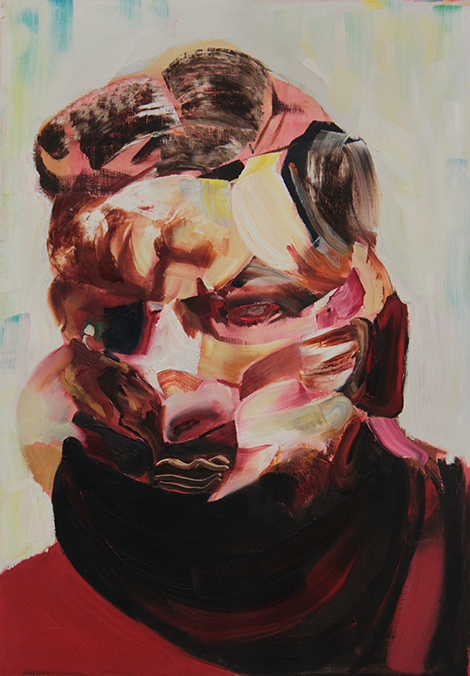Your cart is currently empty!
Adrian Ghenie

Romanian painter Adrian Ghenie’s work is clearly indebted to that of his artistic forbearers. Not since Anselm Kiefer has a painter dealt so explicitly with the heavy, fraught history of 20th century Europe, and like Francis Bacon, his visages are rendered as swirling, gaping horrors. There are references to Frank Auerbach’s thick smears of paint and Munch’s ghastly luridness, all effectively employed to entice and disturb. Nevertheless, Ghenie’s work is strikingly original in its mingling of pleasure and dread, its almost cheeky engagement with the horrors of history, and its unabashed sensuousness of material and form.
The several portraits in the exhibition feature faces from the neck up, filling almost the entire picture plane. Playing with the line between abstraction and figuration, facial features are fashioned in thick oil paint of fleshy reds and pinks, smoothed and scraped in various directions to virtually efface the noses, eyes and mouths. Self Portrait in 1945 (all works 2015) is Ghenie with the black turtleneck and rawness of a mid-century existentialist, and Self Portrait in Winter is the artist swathed in a heavy scarf. Lidless Eye is modeled after one of van Gogh’s self-portraits; it is a puffy, tortured face of chunky strokes of paint that exemplifies Ghenie’s uniting of subject and method.
The figure is also present in The Bridge, a clear homage to Munch with its depiction of a desolate man with a ravaged face peering off the side of a bridge. The green of the bridge and yellow of the field in the background are more muted colors than those of other works, but Ghenie’s method of dripping and scraping and his overlay of light, squiggly gray lines resembling streaks of rain brings an ominous mood to the work.

Ghenie also references specific moments in European history when reason seems to have been replaced by madness, such as in Degenerate Art and Degenerate Art 3. His allusion to Hitler’s frenzied vilification of modern painters is heightened by the kaleidoscopic colors used, reminiscent of artists included in the Degenerate Art Exhibition of 1937 such as Marc, Klee and Chagall. Burning Books may allude to the Bonfire of the Vanities; it features a man and a woman tossing books into the brightly burning conflagration. The subject may be grim and the faces of the man and woman ghoulish, but Ghenie renders the fire in jewel-like tones, beguiling us with its flickering beauty as it consumes the texts of human progress and civilization.
The exact moment depicted is not as clear in The Arrival, placed prominently at the beginning of the exhibition, but its disorienting image of a man with a thick moustache and bowler hat looking over his shoulder as he wanders into a lush jungle of green fronds and a prismatic, roiling sky can act as a metaphor for the viewer’s entry into Ghenie’s darkly seductive world.